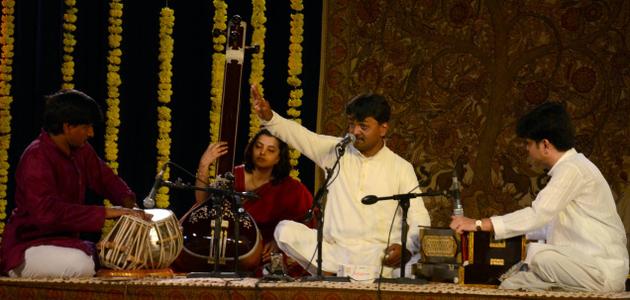Hindustani vocal by Pt.Jayateerth Mevundi at Kalakshetra, Thiruvanmiyur. Photo: M. Karunakaran
It was a memorable evening as each musician, at the Gharana Festival, rendered songs in their own style.
The Gharana Festival organised by the South Zone Cultural Centre Thanjavur, in association with Kalakshetra Foundation and Prakriti Foundation was just a celebration of the Gharana tradition. Three performances traced the legacies of the Gharana musicians and offered a comment on the orderly pedagogy of three illustrious musicians while also revealing the extent of their command over music.
The first evening’s performance was by Pt. Jayateerth Mevundi, who presented Puriya Dhanshri in a strong full-throated voice. Leisurely wading through the mandre saptak and developing it note by note, his voice appeared almost as if it were scaling a pyramid treating the three octaves as if they were one. This is a specialty of the Kitana style that has no curves and abrupt endings. The bandish in Miyan Malhar, ‘Kari Mana Mat’ and the beautiful bol aalaps ‘Tera Toon Sai,’ the intricate taan patterns and the meends flowing through the octaves brought out the Been gayaki in his characteristically clear voice.
A piece in ek taal ‘Att Aayee Badariya, Mand Ghumand Garaj Barsat’ was most beautifully rendered and particularly topical. In the thumri in Mishr Gara ‘Jadu Bhare Tere Naina Raseele’ there was great correspondence between the music and the words of the couplet. Purandaradasa’s beautiful Kannada bhajan in Jogia ‘Jo Bhaje Hari Ko Sada’ brought back memories of Pt. Bhimsen Joshi’s performances. Gopal Gudi Bandi on the tabla and Aswin Walawalkar on the harmonium gave excellent support.
FAST SARGAMS
On the next day, Pt. Vinayak Torvi presented Puriya Kalyan in vilambit for ‘Aaj Soban’ followed by a piece set to madhya laya ‘Bahut Dhin Beete.’ This in turn was followed by a tarana in ek taal, wherein the artist embellished the raga with fast sargams in a deep guttural voice.
Pt. Torvi also spoke of the relevance of the Gharana tradition and how proficiency in one style could lead to the appreciation and understanding of the other. A seasoned performer, he showcased the Gwalior style in his presentation of Raga Tilak Kamod, ‘Ee Guru Jan Khuda Manna’ and the Agra Rangila gharana style through the enunciation of Nom Tom Alap in Jaijaivanti—a well known piece ‘Damani Damke Dar More Laage.’ In this he beautifully exhibited the Des Ang. He concluded with a Kannada bhajan and another popular one, ‘Jamuna Ke Teer.’ Pt. Vyasamurty Katti on the harmonium and Gurumurthy Vaidya on the tabla lent able support.
POWERFUL TAANS
On the final day, Pt. Kaivalya Kumar, once again an outstanding exponent of the Kirana gharana filled the atmosphere with powerful taans embellished with murkis and tuneful renditions ending with tihaais. ‘Dhan Dhan Balam Sajan,’ a most evocative delineation of Raga Gavati brought out the meditative and aspects of poetic compositions. Traversing from ‘sa’ to ‘sa’ in three octaves with impressive feats of musicality in the dhrut ‘Paran Paayo Rey’ in teen tal and ‘Gunnat Gaayo Rey’ in ek taal, his portrayal of musical expressions was most exquisite. A thumri in Des ‘Rang Chunnari Bhigi Rang’ with laad and tappa ang extenuated the poignant nuances of the swara extolling the gayaki of Abdul Karim Khan and Abdul Wahid Khan Sahib. Zhoola was the tour de force of the evening – ‘Ambuya Ki Daari Pe Zhoola Zhulaave Chalo Sakhi Sab Mil Mangal Gaanve.’ Shridhar Mandare on the tabla and Ravindra Katoti on the harmonium brought the weight of tradition to bear on this beautifully produced performance.
The evenings at Kalakshetra proved that while the walls of the Gharana are more porous now, leading to unconscious lending and borrowing between styles, each performer at the festival left his personal stamp on the ragas, making the evenings a memorable experience.
source: http://www.TheHindu.com / Home> Arts> Music / by Jyoti Nair / July 26th, 2012
